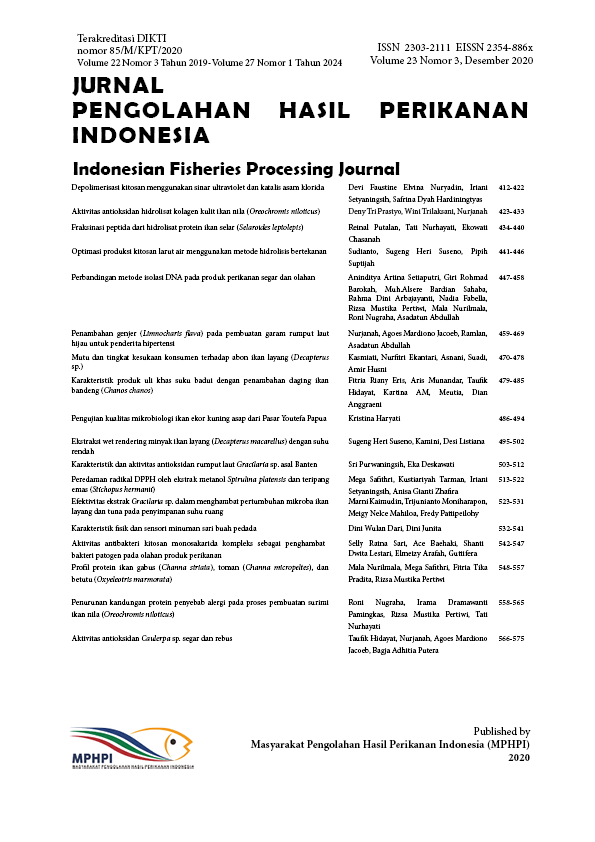Penurunan Kandungan Protein Penyebab Alergi pada Proses Pembuatan Surimi Ikan Nila (Oreochromis niloticus) Reduction of Allergenic Proteins during Processing of Tilapia (Oreochromis niloticus) Surimi
Abstract
Parvalbumin, a sarcoplasmic protein is the main causative protein of fish allergy. It has been known that during surimi production, many sarcoplasmic proteins are washed away. Thus, this research was aimed to determine the effect of washing processes during surimi production as well as heating and enzyme addition to the parvalbumin content. The protein content of surimi was profiled using sodium-deodecyl sulfate polyacrylamide gel electrophoresis (SDS-PAGE) and their intensity was measured. Washing processes removed sarcoplasmic proteins as indicated by the reduction of the number of bands as well as intensities of protein from surimi samples in the SDS-PAGE. Furthermore, the profile of proteins in the washing solutions was similar to that of raw tilapia extract suggesting majority of proteins from tilapia meat were soluble in the washing solution. The parvalbumin content in the surimi was reduced up to 95% by washing processes, while heating and addition of enzyme did not greatly affect. As allergenicity of fish products correlate with the parvalbumin content, surimi may be used as an alternative hypoallergenic source of fish protein.
References
Azadian, M., M. Moosavi-Nasab and E. Abedi. 2012. Comparison of functional properties and SDS-PAGE patterns between fish protein isolate and surimi produced from silver carp. European Food Research and Technology 235(1): 83-90.
Bradford, M. M. 1976. A rapid and sensitive method for the quantitation of microgram quantities of protein utilizing the principle of protein-dye binding. Analytical Biochemistry 72(1-2): 248-254.
Flores Kim, J., N. McCleary, B. I. Nwaru, A. Stoddart and A. Sheikh. 2018. Diagnostic accuracy, risk assessment, and cost-effectiveness of component-resolved diagnostics for food allergy: A systematic review. Allergy 73(8): 1609-1621.
Gam, L.-H., C.-Y. Leow and S. Baie. 2006. Proteomic analysis of snakehead fish (channa striata) muscle tissue. Malaysian Journal of Biochemistry and Molecular Biology 14: 7.
He, K. 2009. Fish, Long-Chain Omega-3 Polyunsaturated Fatty Acids and Prevention of Cardiovascular Disease—Eat Fish or Take Fish Oil Supplement? Progress in Cardiovascular Diseases 52(2): 95-114.
Kobayashi, Y., T. Yang, C.-T. Yu, C. Ume, H. Kubota, K. Shimakura, K. Shiomi and N. Hamada-Sato. 2016. Quantification of major allergen parvalbumin in 22 species of fish by SDS–PAGE. Food Chemistry 194: 345-353.
Koppelman, S. J., J. A. Nordlee, P. W. Lee, R. P. Happe, M. Hessing, R. Norland, T. Manning, R. Deschene, G. A. H. De Jong and S. L. Taylor. 2012. Parvalbumin in fish skin-derived gelatin: is there a risk for fish allergic consumers? Food Additives & Contaminants: Part A 29(9): 1347-1355.
Kristinsson, H. G. and Y. Liang. 2006. Effect of pH-Shift Processing and Surimi Processing on Atlantic Croaker (Micropogonias undulates) Muscle Proteins. Journal of Food Science 71(5): C304-C312.
Kurata, K., M. Itoh, M. Matsumiya, A. Dobashi, Y. Itagaki and K. Shiomi. 2017. Preparation of Hypoallergenic Kamaboko: Removal of Parvalbumin and Collagen from Fish Meat by Water-bleaching, Mechanical Grinding and Extraction with Potassium Chloride. Journal of Cookery Science of Japan 50(4): 141-150.
Mahawanich, T., J. Lekhavichitr and K. Duangmal. 2010. Original article: Gel properties of red tilapia surimi: effects of setting condition, fish freshness and frozen storage. International Journal of Food Science & Technology 45(9): 1777-1786.
Nugraha, R., S. D. Kamath, E. Johnston, K. R. Zenger, J. M. Rolland, R. E. O'Hehir and A. L. Lopata. 2018. Rapid and comprehensive discovery of unreported shellfish allergens using large-scale transcriptomic and proteomic resources. Journal of Allergy and Clinical Immunology 141(4): 1501-1504.e1508.
Ochiai, Y. and H. Ozawa. 2020. Biochemical and physicochemical characteristics of the major muscle proteins from fish and shellfish. Fisheries Science 86(5): 729-740.
Ouellet, V., J. Marois, S. J. Weisnagel and H. Jacques. 2007. Dietary Cod Protein Improves Insulin Sensitivity in Insulin-Resistant Men and Women: A randomized controlled trial. Diabetes Care 30(11): 2816-2821.
Ruethers, T., M. Raith, M. F. Sharp, M. Koeberl, J. N. Stephen, R. Nugraha, T. T. K. Le, S. Quirce, H. X. M. Nguyen, S. D. Kamath, S. S. Mehr, D. E. Campbell, C. R. Bridges, A. C. Taki, I. Swoboda and A. L. Lopata. 2018. Characterization of Ras k 1 a novel major allergen in Indian mackerel and identification of parvalbumin as the major fish allergen in 33 Asia-Pacific fish species. Clinical & Experimental Allergy 48(4): 452-463.
Ruethers, T., A. C. Taki, E. B. Johnston, R. Nugraha, T. T. K. Le, T. Kalic, T. R. McLean, S. D. Kamath and A. L. Lopata. 2018. Seafood allergy: A comprehensive review of fish and shellfish allergens. Molecular Immunology 100: 28-57.
Stephen, J. N., M. F. Sharp, T. Ruethers, A. Taki, D. E. Campbell and A. L. Lopata. 2017. Allergenicity of bony and cartilaginous fish - molecular and immunological properties. Clinical & Experimental Allergy 47(3): 300-312.
Wawasto, A., J. Santoso and M. Nurilmala. 2018. KARAKTERISTIK SURIMI BASAH DAN KERING DARI IKAN BARONANG (Siganus sp.). Jurnal Pengolahan Hasil Perikanan Indonesia 21(2).
Authors

This work is licensed under a Creative Commons Attribution 4.0 International License.
Authors who publish with this journal agree to the following terms:
- Authors retain copyright and grant the journal right of first publication with the work simultaneously licensed under a Creative Commons Attribution License that allows others to share the work with an acknowledgement of the work's authorship and initial publication in this journal.
- Authors are able to enter into separate, additional contractual arrangements for the non-exclusive distribution of the journal's published version of the work (e.g., post it to an institutional repository or publish it in a book), with an acknowledgement of its initial publication in this journal.





